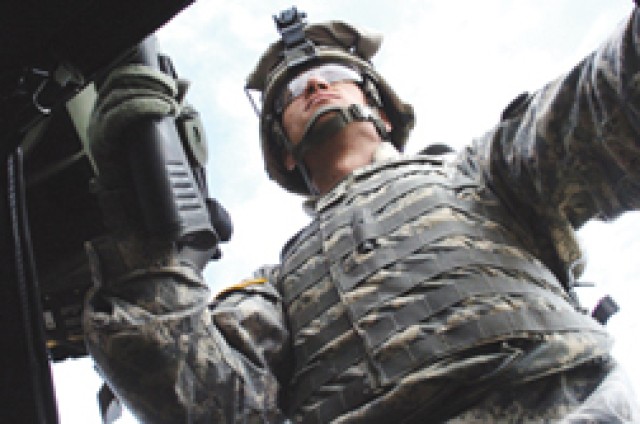CAMP GUERNSEY, Wyo. - When travelling, people often select the best, most convenient roads possible; however, cavalry scouts training at Camp Guernsey, Wyo. April 9, opted for the worst, most rugged routes imaginable.
The Soldiers are assigned to 3rd Platoon, Troop B, 3rd Squadron, 89th Cavalry Regiment, and they were conducting route reconnaissance and rough-terrain driving training to prepare for an upcoming deployment to Afghanistan. The platoon leader, 2nd Lt. Vitaliy Plokhovskyy, said 3rd Plt's mission included conducting a route reconnaissance of the unit's southern boundary and ammunition supply point and confirming or denying possible smuggling routes in Dead Horse Canyon.
"We will have some information from the people whom we replace (downrange), but we need to add something more based upon what we think about the area; so we'll conduct recon (reconnaissance) before we do anything else," said Plokhovskyy. "It is highly likely we will do some missions like this once we get there (Afghanistan)."
He said performing route reconnaissance and rough-terrain driving is good training for his Soldiers because there are a lot of large hills in their operating environment. The training helps familiarize his Soldiers, especially drivers, with traversing rough terrain and allows his gunners to get to know the terrain.
"Now, instead of just scanning left and right, they can also look up and look down," said Plokhovskyy. "It gives them perspective from the terrain we are going to be looking at, so it will be pretty significant I think."
Pfc. Logan Smith drove one of 3rd Platoon's vehicles during the rough-terrain driving training April 9. There were a couple of difficult driving situations during the training when Smith said he didn't completely trust himself and he relied on guidance from his leadership to help him through.
Smith said the rough-terrain driving was great, especially because of the mountainous terrain in the area. "There are a lot of rocks, hills and just a lot of things that would make it a rough-terrain drive," he said.
Not completely unfamiliar with off-road driving, Smith said he has driven a civilian vehicle in similar conditions back home in southern Illinois. While he has never driven up and down mountainsides, just knowing the correct gear to be in and his civilian off-road driving experience helped him.
"(You must) stay confident with yourself," advised Smith. "Have a positive attitude and just listen to your leadership and you will be alright."
Plokhovskyy said he and his Soldiers found a few routes that were not depicted on their maps.
They documented the routes and reported them to higher headquarters, which will help construct an overall intelligence picture of their OE when compiled with similar reporting data from brother platoons responsible for other sectors. It was a good day for 3rd Platoon.
"Today was perfect ... all of the Soldiers performed well, because we gathered a lot of intel (intelligence)," said Plokhovskyy. "I noticed that a lot of the guys are picking up on stuff that they haven't picked up before, so they are stepping up every training (event) that we have."
The ability to see enemies and criminals who cannot see you is a tremendous asset for cavalry scouts performing route reconnaissance. The Long Range Advanced Scout Surveillance System, LRASS, is a valuable tool scouts use to accomplish their missions without being detected.
"It enables a scout to see a lot farther than the naked eye (can), or even most of his (other) optics allow him to," explained Sgt. David Loremayo, platoon leader's gunner assigned to 3rd Plt, Troop B. "With an LRASSS, we can look at an object that we might think, from a distance, is a rock but could actually be a human being. We could be sitting 20 clicks (kilometers) away and they have no idea we are watching them. For scouts, it is very vital."
During area-reconnaissance missions, scouts are constantly making mental notes, said Loremayo. Being ahead of the main body, it is critical for scouts to know what is in their OE; be it roads, bridges, hills or other concerns. This knowledge allows scouts to report to commanders what equipment they can and cannot use in certain areas.
Sometimes scouts dismount their vehicles to recon an area and accomplish their missions. In some cases, this happens because vehicles cannot traverse a particular area, but there is another tactical reason for going dismounted.
"Your vehicle is a large object, especially when you have a gunner and a weapons system. By sending a single dismount (to recon an area), he (the dismount) can get on the ground flat and present maybe a one-foot tall silhouette, whereas a vehicle presents maybe a 10-foot silhouette," explained Loremayo. "We are scouts. We are (performing) reconnaissance of the area, so we don't want to be seen; we want to see what is out there."
Basically, performing area reconnaissance and seeing while not being seen sums up the mission for scouts. However, cavalry scouts successfully accomplishing their mission opens windows to many more missions such as delivering humanitarian aid or meeting and greeting village leaders, explained Loremayo.
"This is just the first part of a mission. On deployment, when you get on ground, the first thing you are going to do is go out and see what is out there," said Loremayo. "You are not going to go out there and instantly engage a key leader; you are not going to go out there and instantly hand out aid; you are going to find out what is out there and what you have to work with. So, this is (a) very realistic (view) of what we are going to do in country."




Social Sharing